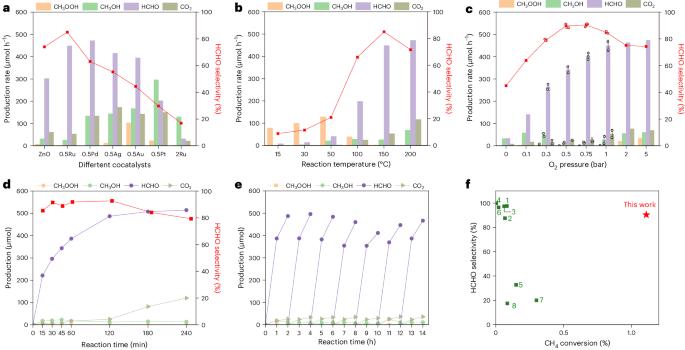Efficient methane oxidation to formaldehyde via photon–phonon cascade catalysis
IF 27.1
1区 环境科学与生态学
Q1 ENVIRONMENTAL SCIENCES
引用次数: 0
Abstract
The oxidation of methane to value-added chemicals provides an opportunity to use this abundant feedstock for sustainable petrochemistry. Unfortunately, such technologies remain insufficiently competitive due to a poor selectivity and a low yield rate for target products. Here we show a photon–phonon-driven cascade reaction that allows for methane conversion to formaldehyde with an unprecedented productivity of 401.5 μmol h−1 (or 40,150 μmol g−1 h−1) and a high selectivity of 90.4% at 150 °C. Specifically, with a ZnO catalyst decorated with single Ru atoms, methane first reacts with water to selectively produce methyl hydroperoxide via photocatalysis, followed by a thermodecomposition step yielding formaldehyde. Single Ru atoms, serving as electron acceptors, improve charge separation and promote oxygen reduction in photocatalysis. This reaction route with minimized energy consumption and high efficiency suggests a promising pathway for the sustainable transformation of light alkanes. Sustainable methane oxidation has the potential to green the petrochemical industry. Here the authors demonstrate a cascade catalysis process involving photoconversion and then thermal decomposition at mild temperatures to form formaldehyde with a high selectivity and a high yield rate.

通过光子-声子级联催化将甲烷高效氧化为甲醛
将甲烷氧化成增值化学品为利用这种丰富的原料进行可持续石化提供了机会。遗憾的是,由于目标产品的选择性差、产率低,此类技术仍然缺乏竞争力。在这里,我们展示了一种光子-声子驱动的级联反应,该反应可将甲烷转化为甲醛,在 150 °C时,生产率达到前所未有的401.5 μmol h-1(或40,150 μmol g-1 h-1),选择性高达90.4%。具体地说,使用装饰有单个 Ru 原子的氧化锌催化剂,甲烷首先与水反应,通过光催化选择性地生成过氧化氢甲烷,然后经过热分解步骤生成甲醛。单个 Ru 原子作为电子受体,可改善电荷分离,促进光催化过程中的氧还原。这种能耗最小、效率高的反应路线为轻质烷烃的可持续转化提供了一条前景广阔的途径。可持续甲烷氧化具有绿化石化工业的潜力。作者在此展示了一种级联催化过程,先进行光催化,然后在温和的温度下进行热分解,以高选择性和高产率生成甲醛。
本文章由计算机程序翻译,如有差异,请以英文原文为准。
求助全文
约1分钟内获得全文
求助全文
来源期刊

Nature Sustainability
Energy-Renewable Energy, Sustainability and the Environment
CiteScore
41.90
自引率
1.10%
发文量
159
期刊介绍:
Nature Sustainability aims to facilitate cross-disciplinary dialogues and bring together research fields that contribute to understanding how we organize our lives in a finite world and the impacts of our actions.
Nature Sustainability will not only publish fundamental research but also significant investigations into policies and solutions for ensuring human well-being now and in the future.Its ultimate goal is to address the greatest challenges of our time.
 求助内容:
求助内容: 应助结果提醒方式:
应助结果提醒方式:


